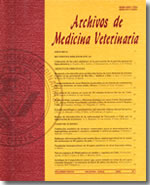Analytical methodology for the detection of ivermectin residues in milk samples from dairy farms in the province of Ñuble, Chile
Main Article Content
Abstract
A study was undertaken in order to validate a precise and reliable analytical method for ivermectin detection and quantification in milk and to determine the presence of ivermectin’s residues in milk samples taken from dairy farms in the province of Ñuble. Analytical methodology was adequately validated using drug free milk samples fortified with increasing concentrations of ivermectin (0.5 to 25 ng/mL), which were subjected to solid phase extraction and analyzed by high performance liquid chromatography. Milk samples were taken from the storage tanks of medium and high productive level dairy farms in the province of Ñuble. Samples were collected in the four different season of the year: Summer (january), Fall (april), Winter (august) and Spring (November). The limit of quantification of the analytical method was established to be 0.043 ng/mL. The absence of interferences and the adequate symmetry of the chromatograms suggest a good specificity of the method, with a recovery ranging from 73.5 to 79.5% for the minimal and maximal drug concentration, respectively. The analytical method presented satisfactory results of specificity, precision and accuracy that allow its use for the detection of residues of ivermectin in milk. Of 96 milk samples obtained from the storage tanks of dairy farms in the province of Ñuble, 8.3% presented ivermectin concentrations which were greater than the limit of quantification of the analytical method. These results demonstrate that it is possible to find ivermectin residues in milk and they justify further studies in order to detect the presence of these drugs in milk, as their presence is a negative attribute in terms of quality.

